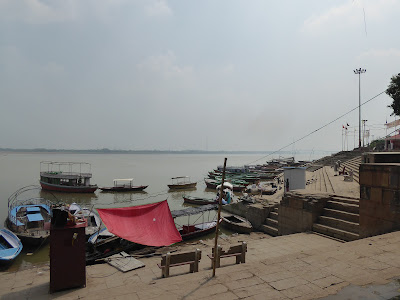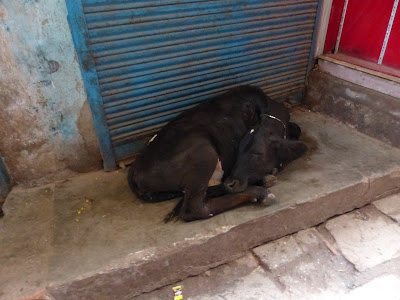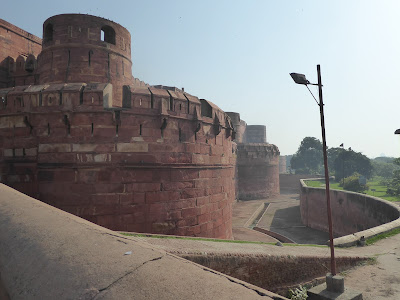Morning flight out of Delhi to Varanasi and then onto our hotel the Radisson.
One of India’s holiest cities, Varanasi, is situated on the banks of the sacred River Ganges. The place is a maze of narrow alleys, full of people heading down to the already crowded waterfront ghats (ceremonial steps). At the water’s edge, the faithful come to wash away their sins, to cremate their loved ones, or carry on the business of hotel laundry. Asi Ghat is one of the largest and most sacred ghats where pilgrims come to bathe. The river wasn’t stinking as I expected it to be, but there is no way either of us are getting in for a bathe.
From the Ghat we went to the Durga Temple, commonly known as the ‘Monkey Temple’ due to the many monkeys which have made it their home. The temple is deep red colour and although we were not allowed inside a walk around the temple is supposed to bring luck to you so off we went leaving our shoes in the capable hands of the shoe attendant.
We glimpsed at the most famous of all Varanasi’s temples, the majestic Kashi Vishwanath which is dedicated to Lord Shiva. Built and razed to the ground several times over its history, the current structure dates from 1776. The 800kg of gold used to cover the two domes of the temple were donated by Maharaja Ranjit Singh of Lahore which has led to the temple being often referred to as ‘the Golden Temple of Varanasi’. The Gyan Kupor Well, ‘the well of knowledge’, is located on the northern side of the temple and its sacred waters are purported to lead its drinkers to a higher spiritual plane.
One of India’s holiest cities, Varanasi, is situated on the banks of the sacred River Ganges. The place is a maze of narrow alleys, full of people heading down to the already crowded waterfront ghats (ceremonial steps). At the water’s edge, the faithful come to wash away their sins, to cremate their loved ones, or carry on the business of hotel laundry. Asi Ghat is one of the largest and most sacred ghats where pilgrims come to bathe. The river wasn’t stinking as I expected it to be, but there is no way either of us are getting in for a bathe.
From the Ghat we went to the Durga Temple, commonly known as the ‘Monkey Temple’ due to the many monkeys which have made it their home. The temple is deep red colour and although we were not allowed inside a walk around the temple is supposed to bring luck to you so off we went leaving our shoes in the capable hands of the shoe attendant.
We glimpsed at the most famous of all Varanasi’s temples, the majestic Kashi Vishwanath which is dedicated to Lord Shiva. Built and razed to the ground several times over its history, the current structure dates from 1776. The 800kg of gold used to cover the two domes of the temple were donated by Maharaja Ranjit Singh of Lahore which has led to the temple being often referred to as ‘the Golden Temple of Varanasi’. The Gyan Kupor Well, ‘the well of knowledge’, is located on the northern side of the temple and its sacred waters are purported to lead its drinkers to a higher spiritual plane.
As the end of the day approached we headed back down through the crowds to the Ganges for a sunset ride on the river, from the boat we experienced the emotional waterfront cremations, and then back to moor up at the Dasaswamedh Ghat, for the Aarti Ceremony. This ceremony takes place every sunset for the tourists. It is a highly choreographed ceremony performed on a stage by a group of young pandits (priests), all draped in saffron colored robes with their puja plates spread out before them. It commences with the blowing of a conch shell, and continues with the waving of incense sticks in elaborate patterns and circling of large flaming lamps that create a bright hue against the darkened sky. The movement of the lamps, held in the pandits' hands, is tightly synchronizing to the rhythmic chants of hymns and clang of cymbals. The ceremony is quite long and by the end legs, backs and everything else was aching from sitting on the wooden planks of the boat. We made our weary way back to the hotel amongst the hordes of happy visitors.
In the early morning we went on another boat ride on the River Ganges, this time to watch the city come alive as dawn breaks. The devotees head to the riverbank ghats to worship the rising sun. Some come for a ritual bath, others to cremate their loved ones, and while these spiritual practices are taking place others are there wash their clothes or the hotel laundry. Quite simply an amazing experience.
Later we fly out of Varanasi to Khajuraho.



















































